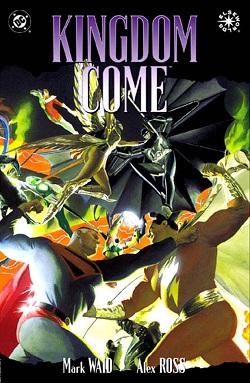
Kingdom Come is a four-issue comic book miniseries published in 1996 by DC Comics under their Elseworlds imprint. It was written by Mark Waid and Alex Ross and painted in gouache by Ross, who also developed the concept from an original idea.

Elseworlds is the publication imprint for American comic books produced by DC Comics for stories that take place outside the DC Universe canon. Elseworlds publications are set in alternate realities that deviate from the established continuity of DC's regular comics. The "Elseworlds" name was trademarked in 1989, the same year as the first Elseworlds publication.
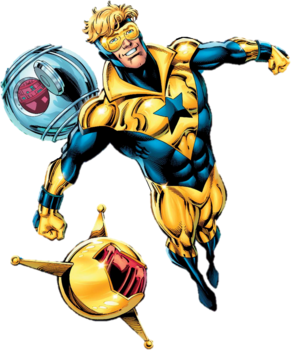
Booster Gold is a superhero appearing in American comic books published by DC Comics. Created by Dan Jurgens, the character first appeared in Booster Gold #1 and has been a member of the Justice League.

Nelson Alexander Ross is an American comic book writer and artist known primarily for his painted interiors, covers, and design work. He first became known with the 1994 miniseries Marvels, on which he collaborated with writer Kurt Busiek for Marvel Comics. He has since done a variety of projects for both Marvel and DC Comics, such as the 1996 miniseries Kingdom Come, which he also cowrote. Since then he has done covers and character designs for Busiek's series Astro City, and various projects for Dynamite Entertainment. His feature film work includes concept and narrative art for Spider-Man (2002) and Spider-Man 2 (2004), and DVD packaging art for the M. Night Shyamalan film Unbreakable (2000). He has done covers for TV Guide, promotional artwork for the Academy Awards, posters and packaging design for video games, and his renditions of superheroes have been merchandised as action figures.
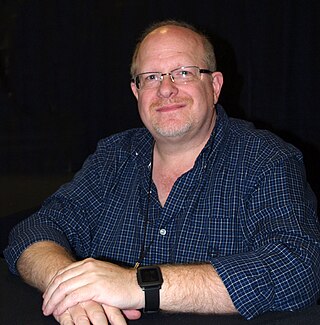
Mark Waid is an American comic book writer best known for his work on DC Comics titles The Flash, Kingdom Come and Superman: Birthright as well as his work on Captain America, Fantastic Four and Daredevil for Marvel. Other comics publishers he has done work for include Fantagraphics, Event, Top Cow, Dynamite, and Archie Comics.

Wallace Rudolph "Wally" West is a superhero appearing in American comic books published by DC Comics as the original Kid Flash and the third Flash. His power consists mainly of superhuman speed. The nephew of Iris West, he first appeared in Flash #110 (1959), which depicted his transformation into Kid Flash. Under the mantle of Kid Flash, Wally was depicted as a teenage sidekick to his uncle-by-marriage, Barry Allen, and a founding member of the Teen Titans. After Barry's death in Crisis on Infinite Earths in 1985, Wally took on the role of the Flash in 1986, and was the main Flash in DC's lineup until Barry returned in The Flash: Rebirth in 2009. He would later return as the main Flash in 2021, as part of the Infinite Frontier relaunch.
Earth-Two is a setting for stories appearing in American comic books published by DC Comics. First appearing in The Flash #123 (1961), Earth-Two was created to explain differences between the original Golden Age and then-current Silver Age versions of characters such as the Flash, and how the current (Earth-One) versions could appear in stories alongside earlier versions of the same character concepts. Earth-Two includes DC Golden Age heroes, including the Justice Society of America, whose careers began at the dawn of World War II, concurrently with their first appearances in comics. Earth-Two, along with the four other surviving Earths of the DC Multiverse, were merged into one in the 1985 miniseries Crisis on Infinite Earths. However, following the events of Infinite Crisis, the Multiverse was reborn, although the subsequent Earth-Two was not the same as its pre-Crisis equivalent.

Gog is the name of several fictional characters in the comics published by DC Comics. The first version first appeared in New Year's Evil: Gog #1, and was created by Mark Waid and Jerry Ordway.

Nightstar is a fictional character in DC Comics, the daughter of Starfire and Dick Grayson/Nightwing in an alternate universe. She serves as a member of Batman's team Outsiders.
The Linear Men are a fictional superhero team in the DC Comics universe. They first appeared in Adventures of Superman #476.
Hypertime is a fictional concept in DC Comics which first appeared in the 1999 The Kingdom limited series. It is a variation of the Multiverse concept that existed in DC Comics before 1985's Crisis on Infinite Earths limited series and was created by Mark Waid and Grant Morrison.
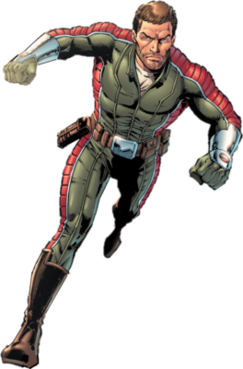
Rip Hunter is a time-traveling superhero appearing in American comic books published by DC Comics. Created by writer Jack Miller and artist Ruben Moreira, the character first appeared in Showcase #20. Following three more appearances in Showcase, Rip Hunter was given his own series which ran for 29 issues (1961–65). He later starred in the eight-issue Time Masters series (1990), written by Bob Wayne and Lewis Shiner. After numerous revisions and following the events of the 2005 "Infinite Crisis" storyline, Hunter is established as the son of Booster Gold.

Magog is a fictional character appearing in comic books published by DC Comics, generally as an enemy and foil to Superman. He first appeared in Kingdom Come #1, and was created by Mark Waid and Alex Ross. In 2009, Magog was ranked as IGN's 75th-greatest comic book villain of all time.

Offspring is a fictional comic book superhero in the DC universe. He is the son of Plastic Man, but did not inherit his powers of elasticity, instead gaining them from a watered down version of the acid that granted the original Plastic Man his powers.

Superman and Batman: World's Funnest is an American single issue prestige format comic book published in 2000 by DC Comics. It was written by Evan Dorkin and illustrated by many artists. It is an Elseworlds tale and as such is not considered part of the main DC canon/continuity. Despite the title, Batman and Superman play only a small role in the story which stars instead Mr. Mxyzptlk and Bat-Mite as the main protagonists. The book pokes fun at many comic book conventions and DC heroes from the Golden through to the Modern Ages. Its setting is a multiverse similar to the Pre-Crisis DCU but also includes references to other Elseworlds tales, the modern DCU, the DCAU and even pays a visit to Crisis on Infinite Earths.

The Reverend Norman McCay is a fictional character from the DC Comics mini-series Kingdom Come, where he acted as the narrator and de facto protagonist. As Kingdom Come is an Elseworlds series, McCay has not been seen in the regular DC Universe continuity, but with the recent revelations in the Justice Society of America title, McCay is apparently a part of DC Comics' multiverse. McCay is a preacher and the witness to the Biblical events of the series.
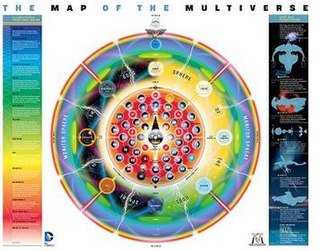
In most of the DC Comics media, the Multiverse is a "cosmic construct" composed of the many fictional universes the stories of DC media take place in. The worlds in the multiverse share a space and fate in common, and its structure has changed several times in the history of DC Comics.

The Superman of Kingdom Come is a fictional character, an alternate version of Superman in the DC Comics universe. First introduced in Kingdom Come #1, Kingdom Come Superman was created by Mark Waid and Alex Ross. The character was loosely adapted in the Arrowverse crossover "Crisis on Infinite Earths", portrayed by Brandon Routh.















